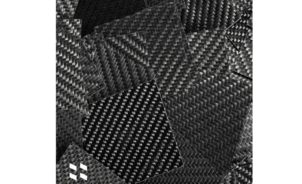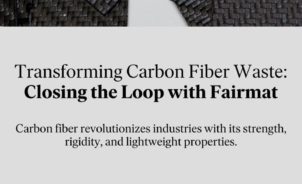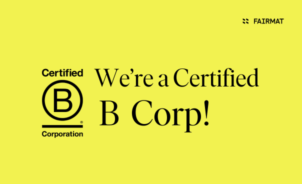According to the European Commission, “Life Cycle Assessment (LCA) provides the best framework for assessing the potential environmental impacts of products currently available.”
Let’s find out how and why.
What will you find in this article?
Fairmat is ‘LCA-verified‘, and through this article, we share our experience in the subject and help you understand the fundamentals of the life-cycle assessment model.
What is Life Cycle Assessment (LCA)?
“Life-cycle assessment (LCA) is a process of evaluating the effects that a product has on the environment over the entire period of its life (or a part of its life cycle), thereby increasing resource-use efficiency and decreasing liabilities.” – EEA.
In simple terms, an ‘X’ object (product/process/service/system) can have a ‘Y’ kind of impact on the environment throughout its life cycle in ‘Z’ kind of ways.
Life cycle assessment is the methodological tool that draws thorough results by evaluating each variable (X, Y & Z) against each other.
For instance, a certain waste recycling method could turn out extremely energy-intensive, thus losing its purpose. However, the recycling customer has limited insight and will continue feeling satisfied with how they operate (or recycle) sustainably, which is not the case in reality.
Therefore, in order to be understandable, sustainability needs to be quantifiable.
Life cycle assessment (LCA) helps ‘quantify’ sustainability.
If used correctly, LCA results can support informed decisions for both suppliers and consumers.
4 Steps of a Lifecycle Assessment:
Four standardized phases of a lifecycle assessment help provide the necessary depth to its results.
1. Definition of Goal and Scope of the LCA:
- LCA’s objective is to explicitly state what aspects have been considered and what falls out of its scope.
- Defining the goal(s) of the study requires outlining the objective for developing the study and stating the limitations, applications, and target audience.
- Subsequently, scope definition involves identifying and defining aspects like the functional unit (e.g., “1 kg steel-sheet; type XY…”) and system boundaries of the object (product/system) under study.
2. Life Cycle Inventory (LCI) analysis:
- LCI analyzes and collects data on all environmental inputs and outputs associated with the studied object (product/system).
- Environmental outputs are what the object emits into the environment during its lifecycle, e.g., GHG. Similarly, metals, energy, etc., constitute the resources (or inputs) the object draws from the environment.
3. Life Cycle Impact Assessment (LCIA):
- The collected data for the inputs and outputs is classified into relevant impact categories like ‘climate change’ or ‘eutrophication.’
- Furthermore, they are characterized by standard units for comparison, i.e., using a single common unit for every impact category: E.g., CO2e for Climate change.
4. Life Cycle Interpretation phase:
- Interpreting the results of LCA is about summarizing the study’s conclusions, stating the limitations of the results, identifying the improvements, and proposing recommendations.
What are ‘Simplified’ Life Cycle Assessments?
Simplified Life Cycle Assessment (sometimes also called Streamlined LCA) is an application of LCA methodology based on a specific level of detail, i.e., it covers the whole lifecycle superficially but with a focus on selected subjects.
Simplified LCA uses generic data and follows a simplified analysis, by focusing only on:
- relevant (or essential) environmental aspects (climate change, energy consumption, etc.)
- or some stages of the object’s life cycle (cradle to grave, cradle to gate, etc.)
- or certain phases of the LCA (4 steps listed above), depending upon the study’s objective.
3 Steps of a ‘Simplified’ Life Cycle Assessment:
1. Screening:
- Identifying the subjects of focus, i.e., the most critical parts of the life cycle or the parts with data gaps for assessment.
2. Simplifying:
- Further developing the previously identified parts.
3. Assessing reliability:
- Ensuring that the LCA’s simplification is not hampering the reliability of its results.
Early design decisions influence 70-80% of the total product cost and environmental impact.
Simplified LCA of Fairmat’s Recycling service and Materials has revealed many opportunities that can be explored to improve the current impact results. But, the comparisons and relative results themselves are very promising. Startups or scale-ups like Fairmat can conduct Simplified Life Cycle Assessments tailored to their early design products and purpose, cost-effectively and iteratively. (Read about our Simplified LCA journey.)
Why and how should you use Life-Cycle Assessment (LCA) results?
Being surrounded by fancy-looking, feel-good ‘eco-labels’ never helped anyone compare one product to another. (Read about the EU’s regulations on Greenwashing)
There’s no quantitative basis to compare sustainability, and when there is, it becomes unreasonable to dive into details when you are not prepared to process them.
Life cycle assessments are the only tools that can be used for product comparisons over the whole life cycle. But the potential of the LCA results is limited because it excludes the social and economic impact.
LCA-based information comes in handy for someone in the Purchasing role (for supplier selection) or responsible for managing a company’s environmental footprint.
LCA results can be effectively used to optimize the use of sustainable materials and processes because they conform to International Standards (ISO 14040 and ISO 14044.)
For instance, Fairmat, as a supplier, uses the simplified LCA results (of the Recycling process) to inform its community of the benefits of using a mechanical recycling service compared to other current practices. We were also able to help our clientele compare the environmental impact of their materials with Fairmat’s recycled materials.
Navigating the application of LCA-results in your ‘purchase or supplier evaluation decisions’ may prove difficult or otherwise, depending upon your enterprise’s environmental ambitions, capacity, and capabilities.
Also, read part 2 and part 3 of the simplified LCA series.




